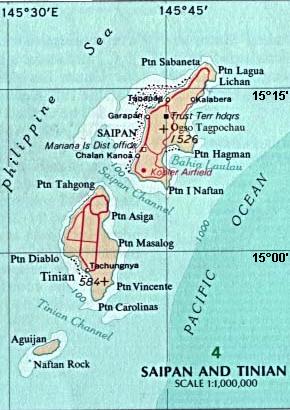Accurate and Fair
The author Hillenbrand writes the episode of the Japanese massacre of 5,000 Koreans twice in "Unbroken," even though it is not directly related to Zamperini's life.Recall her words in an interview;
"It is an understatement to say that I am a driven researcher. I spent seven years on this book because I was researching so obsessively, trying to find every source there was and cross-checking every fact against other sources to be sure my reporting was accurate and fair. In the back of the book, I listed every source for every fact, so anyone who doubted an account could verify it."
From Interview of Laura Hillenbrand, the author of "Unbroken" on US-Japan Dialogue on POWs
http://www.us-japandialogueonpows.org/
I will keep in mind these words.
The Japanese have never heard of the incident before. What kind of source does she present? Is she fair to the Japanese?
The Battle of Tinian
First, where is Tinian? What is the Battle of Tinian?
Map of Saipan and Tinian
Tinian is a part of the Northern Mariana Islands, located only 3.5 miles southwest of Saipan. It was under the Japanese control since 1918. The Battle of Tinian began by the landing of the U.S. Marines on July 24, 1944. Prior to this battle, the U.S. had already occupied Saipan.
U.S. Marines are wading ashore on Tinian
A Marine guy is patrolling around a destroyed Shinto shrine.
After the capture of Tinian by the U.S. on August 1, 1944, Tinian became a base of the B-29 bombers that attacked the Philippines, Okinawa, and mainland Japan. A part of the B-29's that carried out the Great Tokyo Air Raid on March 10, 1945 came from Tinian. The two most famous B-29 bombers, Enola Gay and Bockscar, departed Tinian for dropping the atomic bombs on Hiroshima and Nagasaki in August 1945.
B-29's are about to leave Tinian West Field for bombing over Japan in 1945.
Because Saipan had been already taken, the situation was imminent. The enemy was about to land Tinian. Wouldn't it be better for the Japanese Army to save bullets and get prepared for the battle rather than killing its own people Koreans?
Seventy Years After the Battle...
This year the 70th Anniversary Reunion of Honor ceremony was held to pay tribute to both U.S.and Japanese veterans who fought in Saipan and Tinian.Koreans on Tinian
How many Koreans were living on Tinian at that time? According to Wikipedia, by June 1944, there were about 15,700 Japanese citizens including 2,700 Koreans and 22 ethnic Chamorro. Other sources present the same number.http://en.wikipedia.org/wiki/Tinian
A natural question: how could the Japanese Army kill 5,000 Koreans on Tinian given that the population was about 2,700? Why did Hillenbrand fail to confirm Korean population on Tinian? She tried her best to be accurate, right?
How about the Korean population after the Battle of Tinian? There is a New York Times article dated Feb 5, 1945, reporting 2,400 Koreans living in Tinian gave some donation to the United States.
"Koreans on Tinian Give $666 to U.S. -Grateful for Liberation from Slave Labor Under Japanese, They Contribute to War-"
In summary, it says, being impressed with the U.S. rule, 2,400 Koreans living on the island gave $665.35 to the U.S from their earnings. These Koreans were taken to the island by the Japanese as slave labor on the sugar plantations 6 years ago. Once Tinian was freed, the Koreans attacked the oppressors(!). Under the U.S. rule, they run their own government and the job opportunities are provided by the U.S., etc.
You can find a copy of the article here:
Twenty four hundred Koreans remained on Tinian in February 1945. And the article never mentions the massacre by the Japanese. If it had taken place, for sure the article would have talked about the incident very loudly. Because in Feb.1945, Japan and the U.S. were still under the war. That would be a nice propaganda to the world!
Hillenbrand uses so many New York Times articles as reference in this book. Why didn't she pick this specific one?
Hillenbrand uses so many New York Times articles as reference in this book. Why didn't she pick this specific one?
This number, 2,400 Koreans, matches one provided by a Japanese researcher. In the article, the author reports that Korean survivals are in total 2,341 in August 1945; 905 male adults, 451 female adults, and 985 16 years or under.
The same article says that Korean casualties on Tinian was 50. This number was provided by the research of the Ministry of Health and Welfare (now the Ministry of Health, Labor, and Welfare) in 1977.
The same article says that Korean casualties on Tinian was 50. This number was provided by the research of the Ministry of Health and Welfare (now the Ministry of Health, Labor, and Welfare) in 1977.
The source is
https://toyo.repo.nii.ac.jp/?action=repository_action_common_download&item_id=2401&item_no=1&attribute_id=18&file_no=1
Tsushima, Hideko (2008-03), "Returning from the Northan Mariana Islands to Japan After World War II: A Study on the Migration of the Hachijou Islands," Hakusan Review of Anthropology, vol.11, pp.147-166. You will find Table 1 in p.152.
https://toyo.repo.nii.ac.jp/?action=repository_action_common_download&item_id=2401&item_no=1&attribute_id=18&file_no=1
Tsushima, Hideko (2008-03), "Returning from the Northan Mariana Islands to Japan After World War II: A Study on the Migration of the Hachijou Islands," Hakusan Review of Anthropology, vol.11, pp.147-166. You will find Table 1 in p.152.
So, why Hillenbrand mentions the slaughter of 5,000 Koreans on Tinian Island, even twice? What is her source to verify the existence of the massacre?
(to be continued...)






Good question. Can we write to the author and ask her to explain this?
ReplyDelete